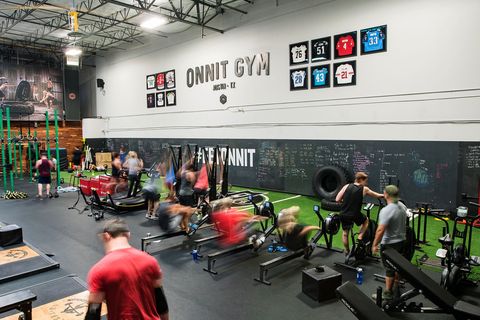
In one corner of an Austin gym, coach Cristian Plascencia has a client crawling along the turf. In another, a broad–shouldered man in his 30s wobbles on (and ten impressive seconds later falls from) a balance board. Near a SkiErg machine, director of sports performance Jeremy Hills yells over the Drake blaring on the PA system, pushing NFL free-agent running back Jamaal Charles through a series of lunges done with a light kettlebell. A hallway away, Sam Pogue, a sports-performance coach, instructs a CrossFit athlete on flawless handstand form.
This isn’t the kind of training you expect to see at your local gym— let alone at the Onnit Academy Gym, a training facility in an office park ten minutes from downtown Austin. This is a gym that counts NHL stars Jonathan Toews and Duncan Keith, Philadelphia Phillies ace Jake Arrieta, and Seattle Seahawks safety Earl Thomas as clients. Shouldn’t its athletes be bench-pressing mounds of weights and dripping pools of sweat?
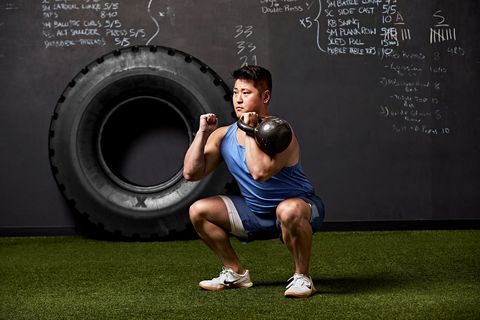
Apparently not. Onnit defies what you know about conventional fitness. The gospel according to Onnit and its trainers preaches that you shouldn’t always lift heavy and you should train with more than barbells and dumbbells. They use maces, clubs, and battle ropes — gimmicks elsewhere — as training staples, promising you’ll feel and function better.
Lofty boasts from a place that didn’t exist five years ago. Before 2014, Onnit was mostly known as a supplement company that peddled fringe-but-buzzy noo-tropics like Alpha Brain, and it had a big-name fan in comedian Joe Rogan.
Onnit CEO Aubrey Marcus wanted to add a fitness arm, so he reached out to John Wolf, a veteran trainer with a love for unconventional methods who was running a gym in California. Wolf came on as chief fitness officer, and over the past three years, he’s established Onnit as a haven for unique training ideas—some of which are worth integrating into your own workouts.
Rotation, Rotation, Rotation
Most certified trainers are schooled to build workouts with a “triplanar” philosophy. This says your body moves in three planes: out in front of you (walking), out to your sides (lateral shoulder raises), and with your upper body twisting.
Wolf, the main architect of Onnit’s approach, talks of something else: rotation. To him, you either create rotation or must resist all rotation during any exercise, from a plank (famous for its anti–rotation challenge) to a pullup, in which your arms subtly rotate. Watching how you manage rotation reveals your weaknesses. “We’re looking at these asymmetrical patterns, asymmetrical loads, and using those to highlight what may be deficient,” Wolf says. “If we address your weakest link, then the whole system is going to benefit.”
This is the advantage of training with maces. Unlike the dumbbells and barbells you typically use, maces and clubs are heavier on one side, creating what’s called an offset load.
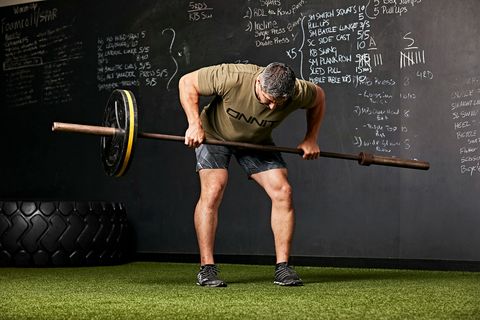
Imagine a barbell with a ten-pound weight only on its left side. Deadlift that bar, gripping it as if it had weight on both ends and keeping it parallel to the ground. The move should fire up your obliques, and doing exercises with a mace or club will accomplish the same.
Good old body-weight moves can also challenge your body rotationally. Do a plank and, without moving your hips, lift your right arm off the ground, reaching it forward. Alternate arms for 45 seconds, then rest for 15; do 3 sets. Or DIY a mace at your gym, placing a five-pound weight on only one side of a barbell.
A New Way to Throw Your Weight Around
The traditional way to add challenge to an exercise: up the weight or reps. But that’s not your only option, thanks to those maces and clubs, which not only add core challenge but also make lighter weights feel heavier. Why? You’re lifting something different from normal. Apart from the physical benefits, it keeps your workout from getting boring. “It’s an opportunity to excite yourself with something other than just the increase in load as a measurement of success,” Pogue says.
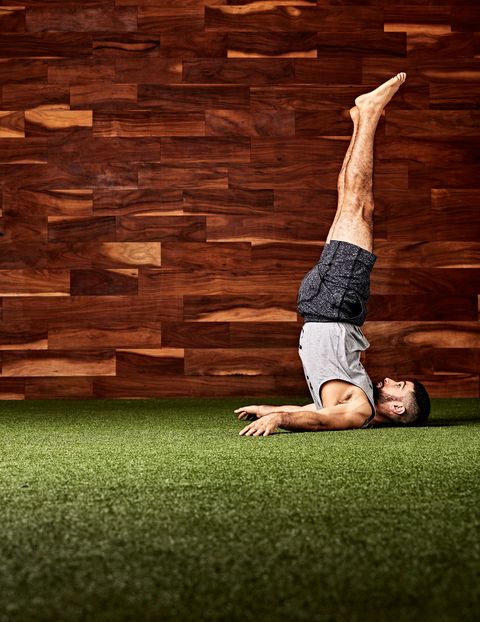
He doesn’t use the word excite lightly. Muscles must adapt to different patterns of resistance with maces and clubs, a key to how Onnit challenges athletes with lighter weights. These exercises also attack stabilizing muscles that get overlooked in barbell and dumbbell training.
But you don’t need maces and clubs to make all this happen. Simply bench-pressing with dumbbells instead of a barbell, or doing lunges while hugging a heavy medicine ball against your chest instead of holding dumbbells at your sides, can challenge your body in a novel way, engaging new stabilizing muscles.
Warmups Are Workouts, Too
If Wolf had his way, you’d ensure training included rest and recovery. Proper recovery stimulates your parasympathetic nervous system, lowering your heart rate and relaxing muscles. Your fast-paced life often stimulates your sympathetic nervous system, accelerating heartbeat and quickening breathing, a state that, if sustained, wears you down.
This isn’t revolutionary; from foam rollers to mobility drills that end CrossFit workouts, fitness has embraced recovery ideas. But Onnit focuses so intently on recovery that Plascencia and others coach a daily “durability” class dedicated to, among other things, mobility drills.
View this post on Instagram
What can recovery and durability look like? . . . We are a longevity and performance system, grounded in movement and exploration. . . . Last weekend we held our Durability Certification at @onnitgymatx. . . . Recovery is not about stopping. It’s about learning to regulate your nervous system. It’s about understanding your boundaries and pushing them functionally, not past the breaking point. . . . Pushing to pain, does not get you gainz. It just gets your broken. . . . Being durable means the ability to withstand wear and tear, not just over the course of a workout, or a competition – but over the course of your life. So you can continue to train, to compete, to live the quality of life you want. . . . When you practice recovery, it should be daily, weekly and programmed to ensure you meet your training goals. This means learning when to dial up intensity and when to dial it down. When to load and when not to. When to return to inward intention and wen you unleash your inner beast. . . . Recovery isn’t all singing bowls (PSA: I love me some singing bowls) – it’s just as badass as your Barbell complexes or any other tool you yield for the greater good. It all comes down to your perspective, awareness and intention. . . . In the second video, @primal.swoledier demonstrates a great variation of dialing up the Durability Floor scorpion with adding in an archer push-up. . . . • In the third slide/video, I’m featuring a recoil and release segment to restore front line/lateral line integration. This is not passive stretching, it’s active tensional restoration. • • Tag a partner and challenge them to this Exercise! • • Posted by Sarah Jamieson, Onnit Academy Durability Master Coach. #durabilitycertified #durabilitycertification #durability #recovery #resilience #resilienceinrecovery #onnit #onnitacademy
A post shared by Onnit Academy (@onnitacademy) on
Wolf often spends 20 minutes of an hour-long session doing joint mobility and activation moves before getting into the primary workout.
Spending that long warming up or cooling down isn’t always practical, so do what you can. If you have five minutes, Plascencia says, you can take the time to move your spine by rolling around on the floor. Yes, really. “Crawling, crouching, rolling; they’re all a big part of a naturally functioning, healthy body,” he says.
That’s why Plascencia loves this drill: Lie on the ground on your back and slowly roll onto your belly and then onto your back again. Next, get on all fours and crawl. Such movements may seem basic, but in a society that spends most of its time sitting and walking, they’re not. “Being able to do something that simple,” says Plascencia, “is a great indicator of how well we truly move.”
Shake Up Your Training
Bored with your workout? Try these two changeups from Onnit.
For a Lightweight Shoulder Burn
Try: Offset Z-Press

River Jordan
Sit on the floor, knees bent slightly, holding a barbell loaded with a light weight on just one side at your shoulders. Have a spotter behind you. Keeping the barbell level, press it overhead. Lower it back to your shoulders, still working to keep it level. That’s 1 rep; do 2 sets of 4 per side.
Add a New Element to Lunges
Try: Club Front-Lunge Press
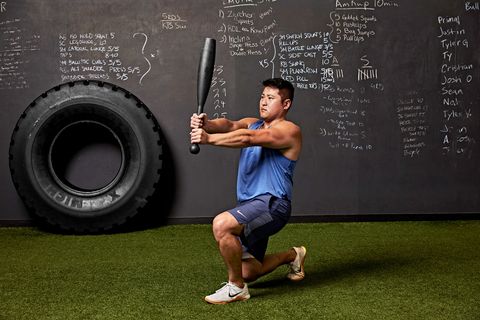
River Jordan
Stand holding a light club at your right hip with both hands, right elbow tucked close to your torso, club head pointed up. Lunge forward on your left leg. As you do this, press the club forward, straightening your arms, still keeping the club head pointed up. Reverse the move. That’s 1 rep; do 3 sets of 10 per side.
Source: Read Full Article
